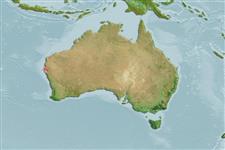Actinopterygii (ray-finned fishes) >
Scorpaeniformes (Scorpionfishes and flatheads) >
Aploactinidae (Velvetfishes)
Etymology: Paraploactis: Greek, para = the side of + Greek, hoplon = weapon + Greek, aktis = ray, sting (Ref. 45335).
Environment / Climate / Range
Ecology
Marine; demersal. Tropical, preferred ?; 25°S - 26°S
Eastern Indian Ocean: known only from Shark Bay, Western Australia.
Size / Weight / Age
Maturity: Lm ? range ? - ? cm
Short description
Morphology | Morphometrics
Ventral surface of lower jaw covered with numerous prickles or papillose villi and with cirri on both inner and outer margins. Isthmus with fleshy pad, its width about 1/4-1/3 of its length (Ref. 39602).
Found inshore, in soft bottom.
Life cycle and mating behavior
Maturity | Reproduction | Spawning | Eggs | Fecundity | Larvae
Paxton, J.R., D.F. Hoese, G.R. Allen and J.E. Hanley, 1989. Pisces. Petromyzontidae to Carangidae. Zoological Catalogue of Australia, Vol. 7. Australian Government Publishing Service, Canberra, 665 p. (Ref. 7300)
IUCN Red List Status (Ref. 115185)
CITES (Ref. 94142)
Not Evaluated
Threat to humans
Harmless
Human uses
More information
Common namesSynonymsMetabolismPredatorsEcotoxicologyReproductionMaturitySpawningFecundityEggsEgg development
Age/SizeGrowthLength-weightLength-lengthLength-frequenciesMorphometricsMorphologyLarvaeLarval dynamicsRecruitmentAbundance
ReferencesAquacultureAquaculture profileStrainsGeneticsAllele frequenciesHeritabilityDiseasesProcessingMass conversion
Tools
Special reports
Download XML
Internet sources
